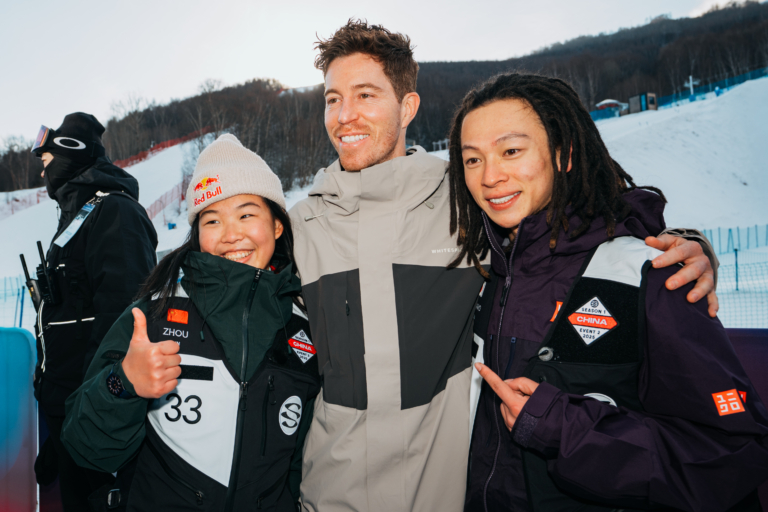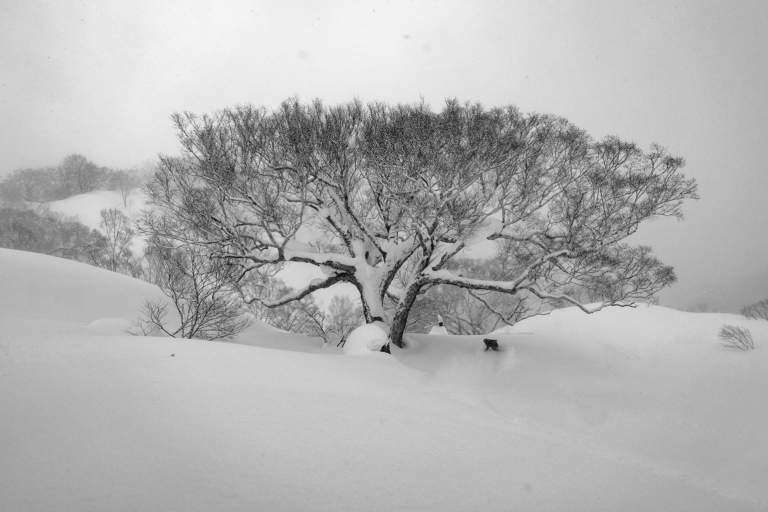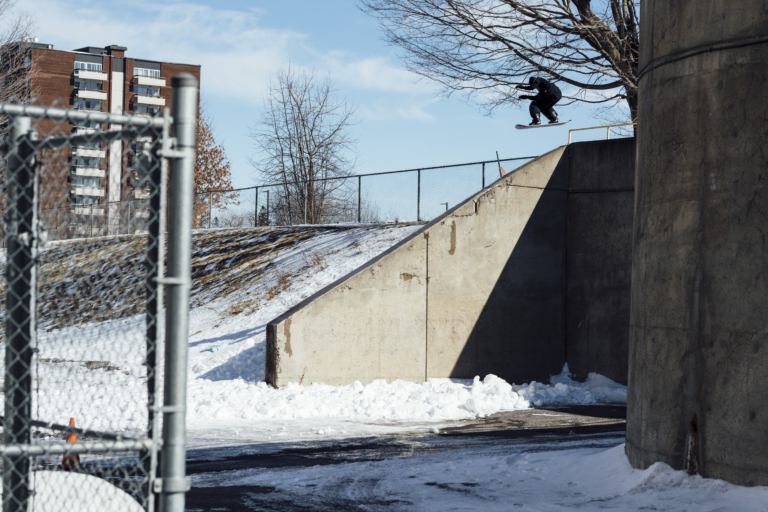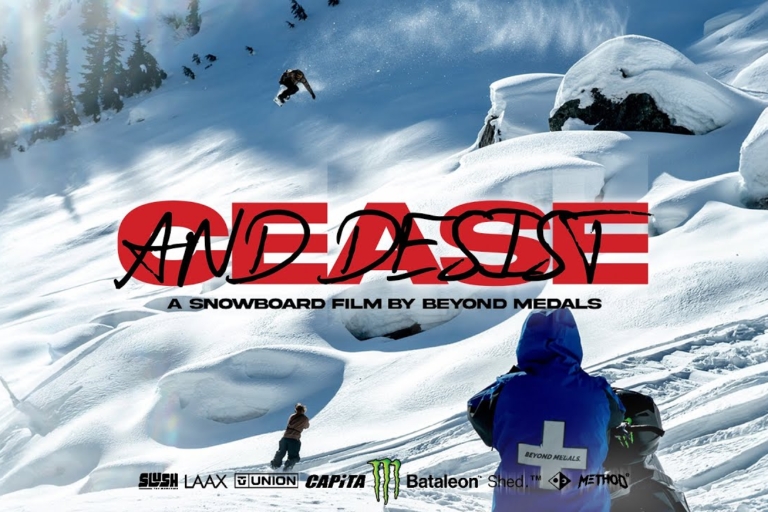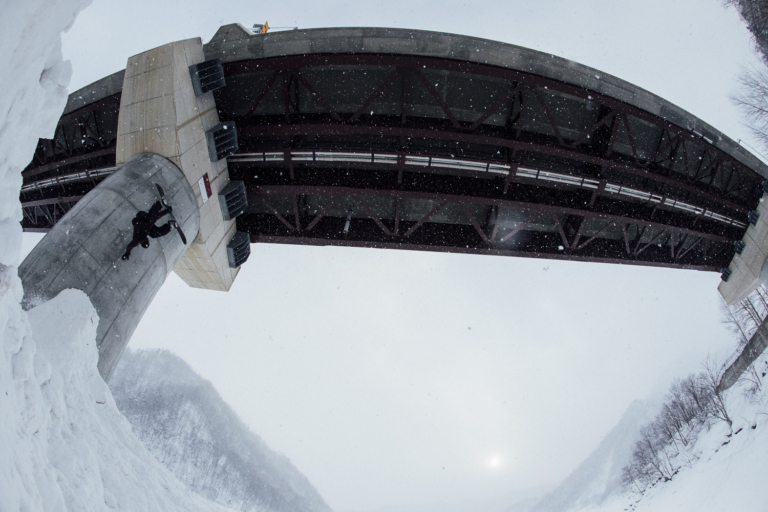Originally published in Issue 20.1.
When Stale Sandbech began competing on the world stage at 14 years old, multi-axis corks were only coming into fruition. Starting immediately and for over a decade, the Norwegian rider was at the tip of the spear as tricks became more nuanced and complex, riding at the highest level during a unique and often polarizing time in the lifespan of snowboarding. But although Stale has medals from every single high-caliber event and has snowboarded in four Olympics (a remarkable feat that includes riding in all three disciplines throughout his tenure), his snowboarding has never been defined by the bounds of contests. And while he has plenty of big, technical spins in his arsenal, he has always offered a counterpoint with an unwavering commitment to style, substance, and the type of snowboarding he believes to be fun and true to himself.

It is this stoic dedication to the essence of snowboarding that bleeds through everything Stale does and everything he rides. He is, first and foremost, a true ATV—a classic breed of rider whose sense of ease in the mountains is intrinsic and ever-evolving. And it is this makes the current inflection point of his career so exciting.
Last season, Stale made the jump from the rigid structure the competition circuit to the open-ended opportunity and weather whims of filming. While the season didn’t go exactly as planned, Stale was still able to spend time in both British Columbia and Alaska, laying the groundwork for a future that has always been incredibly bright, thanks to his innate talent, creative drive, and considered approach. As Stale heads into this winter as a new father and with big aspirations in the mountains, we can’t wait to see what he does next—and for years to come. – Mary T. Walsh
So first off, congratulations! How old is the little one now?
Thank you. Four weeks tomorrow.
You and your girlfriend must be really excited…and maybe sleep-deprived?
A bit of both, for sure. Definitely my lady is dealing with more of the less sleeping because she has to give him food all night. I can’t do that, ha. So we’re getting to know this guy and making a team. It’s summertime and we’re both home, so I’m able to be a dad full-time, which is nice, especially in the first couple months of his life.
The timing’s perfect.
It’s for sure going to be a puzzle this winter to make it work as well as possible, but I definitely want to keep my snowboarding at the same level as it’s been, just now with a family on the side.

Do you think being a father will affect your calculation of risk in the mountains?
For sure, it has an effect on me. Now I am caring for a new life and he’s relying on me, so it’s definitely something you think about. I knew Mariann was pregnant during the winter and I had it in the back of my mind, but I think now that he’s actually here, it’s going to be more real. Throughout my whole career, my snowboarding has always been risk calculated, you could say. I have always moved at my pace—when I feel comfortable and can see the outcome—so I feel like it’s going to be fine.
It’s a balance, I’m sure.
For sure. It’s definitely hard with a lot of risk being involved with what we do. It’s sort of a hard topic, but you just have to know what you’re getting yourself into, take it at your level of comfortability, and have fun. I think the one time I felt it the most was when I was in Alaska this winter for the first time. We were very new to the mountains and to the terrain; I wanted to push, but it was so new to me. I didn’t know all the outcomes. Knowing I was going to become a father, it was probably the first time I really felt that coming into my decision-making. There were some lines I backed off just because I was like, You know what? It’s not the time to push it because it’s my first time here and I have somebody waiting for me at home.
How old were you when you started competing at a high level?
I was 14. I think I was doing finals at the US Open when I was 15.

Your competition career spans a particularly wild time in terms of the evolution of tricks. As the level progressed, how did that affect the relationship that you had with competing? Because you have the big tricks, of course, but always did things your way—for example putting a flat fourteen into slopestyle runs or the double chicane in big air at the Olympics.
I was definitely getting pushed by the level, and we were, at the end especially, riding to please the judges and not just to do the tricks we wanted to. You had to find the right balance between doing what was personally your style, but also had the ability to get points. It was a mind game. But to how crazy the progression was at that time, I’ve been looking back at it and I think it had a lot to do with the people in the contest scene then really pushing each other, but also with YouTube and Instagram and social media coming along.
I think that made the progression go way faster, because we went from…you would X Games and then you would watch the video parts in the fall, so it took a full year or half a year until you saw that next move. Then as soon as YouTube and social media started, if I can take Torstein as an example, he did the first triple cork and it was online a couple of days later. Then the rest of us can see that, “Oh, shit, this is possible,” and we could go out and learn. Through that, the whole process got sped up from a yearly circle to a weekly circle almost, so I think it’s a mix of all of that. The level just exploded.

How was it keeping pace with all of that—the tricks, the rigorous contest schedule—over a decade-and-a-half? I mean, you did four Olympic cycles, which is demanding in and of itself.
At my first Olympics I was so young and my goal was just to make it there. I think between then and the second Olympicswas when it started getting really serious and I was actually competing for the top. I think, for me and how the level exploded, I was in the perfect time because I was one of the guys wanting to push it to the next level. It didn’t feel as much as keeping up, more like, how can I push it forward? How can I stand out? How can I put my signature on this snowboard world, in a way?
That makes sense.
It was just natural and fun and didn’t feel too stressful. It was fueling the fire, competing with Mark, Torstein, Sage, and Seb. We would battle for it; some of the years, Mark and I really had some battles, and it was just fun. I think the last Olympics and the last years, though, it felt more like keeping up. I had tricks and runs that could do well; I knew I had it in my body because I did it for so many years. But when they started spinning even more, my motivation and my mind were more occupied with what tricks I would want to do for video projects.
It reached an inflection point where it was like, “I know I can do this, but is this the direction I want to go?”
I think our generation’s time period was probably from 2013 up until now. Of course, I think this time period has been very exciting with the progression, especially when we started opening up the triple corks. It was a really exciting time in contest snowboarding and there was so much more momentum around the contest scene then, too. I feel like I was lucky to be a part of it. I was lucky to be a part of the last bit of TTR. I really remember the year Kevin Pearce won the TTR World Tour and the whole buzz around that. That era, which from my timeline was the golden era, and then we took the next crazy progression era, and then now it’s the next era…the Marcus Kleveland era,ha, I guess, which is exciting. But I feel it’s just gone out of hand with how much we can spin. Before, it was a shock that a triple cork was possible. It wasn’t as much of a shock that a quadruple was possible, because now it’s like, “Oh.” It’s not a shock if somebody adds another 180 anymore just because it’s already just a crazy thing. Back then it was like, “What the hell is this?” When Torstein did it, it hadn’t even crossed many people’s minds.

Yeah, I agree.
I’m sure there’s going to be something new. I’ve seen crazy new axis of spins and I still see exciting new stuff. I really hope FIS can come up with something that can have that feeling, because they have a free pass without Dew Tours and TTRs. I would like to hope that they will create something that’s not just a qualification for Olympics, but also that people want to follow and that can be that exciting, but let’s just wait and see. At the Olympics, when I said I was going to stop competing, I told the FIS guy just a couple of things. Go talk to some riders. Ask what they want. Try to create something that pleases everyone. But I don’t know, I don’t feel like I’ve seen it since.
This goes into the trick you put down in big air in Beijing. You called it a double chicane, yes?
Yes, or it would be like a switch double front rodeo 1260, but I think because it’s executed a bit differently, not off the toes like a normal switch frontside rodeo, it would be closer to chicane.
That trick really stood out because it was so different.
Yeah, I was stoked on that. I was glad that was my final sign-off from the traditional contest world. I wasn’t really at the Olympics to do big air. I was over big air quite a few years prior to that. I just did it to get points to do slopestyle. So I told myself, If I podium in slopestyle, I won’t do big air. I was just going to travel home. But since I didn’t podium and conditions were quite nice at practice with slush, I was like, Okay, I still have this one trick I want to bring to life. I did it in Real Snow, but I wanted to do it in a competition and leave my mark on the contest scene with that.

I think that was emblematic of your whole competition career. Was it a difficult decision to retire from the contest circuit at that time?
No, it was not a difficult decision. I think it was a more difficult decision the year prior to decide to keep competing and not start filming then.
What happened then?
It worked out. I kept competing and I found my flow at Laax Open before X Games. Prior to that, after Dew Tour and Christmas, I was having a hard time finding, I don’t know, my fire for competing. I felt slow on my board. I felt like I sucked at snowboarding. Then all of a sudden, after riding with some friends, it restarted my brain. That stuff can get to your mind, especially when you’ve done it for so long, and suddenly what normally, naturally came together, isn’t doing that. I almost decided to stop competing then. The Olympics was the last push. Now I have four Olympics in the books. I think that was a cool goal as a snowboarder, but also just as a human. I know my dad is really proud of that accomplishment. It was a good way of signing off, and with doing that trick, it was very natural. I could start filming and put all these ideas I had not on paper, but on the snow.
The Winter Olympics are an especially big deal in Norway, right?
Everybody watches it and we do well; we have the most medal count out of any country. But that also makes it small because we’re very used to getting Olympic medals. When you get a medal it’s big, but the guy next to you might be a cross country skier and he has four gold medals from one Olympics, and you’re there with one silver. It’s like, “Good job, dude.”
That puts things into perspective, ha. So last season, you were planning on filming and spending time in the backcountry, but then things weren’t shaping up as you had hoped?
Yeah, my season did not go as planned at all. My plan was to film my video part of my career. I had a visa issue, and winter never arrived in Europe. Norway was actually pretty good. It was one of the better winters down around Oslo, so I ended up being here a bit because I couldn’t go to the US, where they had the snow season of forever on the West Coast.
Yeah, it was crazy.
At the time, I felt like now it was all in. I could film my video part to put that side of my career on the map, too. It definitely started ramping up toward the end of the season when I got my visa and things came together, but it was far from the winter that I was expecting to have.

You made it over to North America eventually?
Yeah, I ended up getting some stuff done. I was able to join Torgeir, Spenny and Judd in Whistler. I was waiting for my US visa to get approved before I traveled, so I showed up quite late and I was able to join the three last days there, and then I was able to go to Alaska.
You guys were sledding in Whistler?
Yes, and camping.
Oh cool. How was that?
It was good. They had really nice tents, and I was lucky because I showed up late and the camp was already set up, ha. I helped take the camp down, so I did provide some work. Maybe I’m not going to do that every time we go camping, but at least I had an excuse with the visa.
How was the trip overall?
I was able to join some of the best days. Whistler is sick. You’ve seen a lot of footage from there and you think you’ve seen most things there, but there’s just endless terrain.
What type of terrain do you find interesting in the backcountry so far?
It was a bit tricky for me because I was sort of showing up to what was there, end of the season. Those guys were looking for their enders while I was just getting started. The first day, we were hitting this jump that they had hit before I showed up and they wanted to make it bigger. So, we started adding blocks to this jump that was already decent size. We’re about to start the session and this helicopter pulls up that Spenny hired. Spenny jumps in the helicopter, it takes off, and the session is on. I was like, Fuck. I haven’t even hit a jump this year. I had just been riding small pillows and resort backcountry in Norway, not too far from the city. I was almost ready for big lines before hitting a cheese wedge with a helicopter.
Oh man.
I was like, “You guys just got to go first.” I know it’s not a problem for me, hitting this jump, but was sort of it, it’s been a while, ha. And then the session started—potential enders for those guys and I was just warming up, but it was a good way to get thrown into it. After a couple hits, I felt like I was back. It wasn’t scary anymore. But what type of terrain am I driven toward? I like to ride everything. If I ride the same thing too much, I get bored. But I definitely have been driven more toward ways of hitting something naturally or finding terrain that has natural jumps.
And then you went up to AK. Where did you go?
We were in Valdez. We showed up the day after Natural Selection finished, so we met the guys there briefly. We drove up. It took us three days from Vancouver.
Woah, how was the drive?
It was definitely a cool drive. We were rushing though, like crazy. It was even hard to get a pee break in because Spenny and Torgeir just wanted to get there, ha.
Haha. Were you guys driving because you were bringing the sleds up?
Yeah, we were bringing the snowmobiles. They had planned on staying there for a long time, so they wanted to have their cars. It was Spenny and Torgeir in one car and me and Judd in the other, and we drove 12-16 hour days.But it was cool. We got there and ended up sitting for seventeen days waiting for good conditions, so we kind of didn’t need to rush, but you never know in Alaska.
That’s a lot of time to think.
A lot of people have probably experienced that in Alaska; you can sit around, but when you first get it, it’s insane. Those mountains are just a different perspective. Even when I was there, in the beginning I didn’t realize. I would look at a line and I’d think, I can go down there, jump up this cliff, yada yada, and then you get up there and it’s like, Woah, that little cliff that I thought was medium-to-small is fucking gigantic. It was really tricky to plan your lines in the beginning until you understood the perspective, size—and also managing slough and exposure.
It kind of becomes this riddle you have to solve prior to riding. You need to know, Okay, if I do that turn there, the slough is going to go there and down that, so then I have to be on this. It is one thing having the skill to ride down, but having the knowledge and experience to ride down is where it’s a whole new learning curve.
It’s definitely a constant learning process.
Yeah. It’s super hard. I’ve watched movies since I was a kid and when I was younger, the AK parts did not relate to me. I didn’t understand it. I thought, They’re just riding down. They’re not doing tricks. But the older I get, the more I am drawn toward that. And now, I know what it means to ride there. It’s how fast you’re going, how steep it is, how dangerous it is, how fucking sick of a feeling it is. And the slough factor. After getting tackled by slough once, you realize the power of that. It’s like a freaking bull chasing you down—that’s not something that happens on the slopestyle course.
Does Natural Selection interest you in the future?
Definitely. It connects all my passions with snowboarding. I think it would be interesting to turn on the mindset that I have when I compete, but in that setting. It could fit me really well, or it could be very difficult because I’m used to riding slopestyle courses where I can practice multiple times. It’s definitely something I’m interested in.
Going into this season, do you want to try to film that video part you were looking for last year?
Definitely. I just need to have a bit more of a plan in how I travel now, having a child. I can’t just leave New Year’s and come back in May, like I’ve done the last fifteen years. It’s all about the right balance. Mariann is perfect with that because she understands, so she and I are planning on finding a really good solution. And hopefully they can join on certain trips, too. So we’re going to figure out a good way of doing it and hopefully we have a good winter all over the world, for everyone’s sake. That’s going to make it a lot easier. If it’s not a good winter, it’s going to take a bit more work and trying and doing and failing, but we are just going to wait and see.

